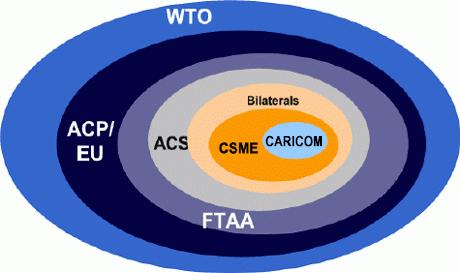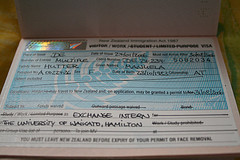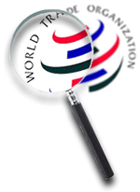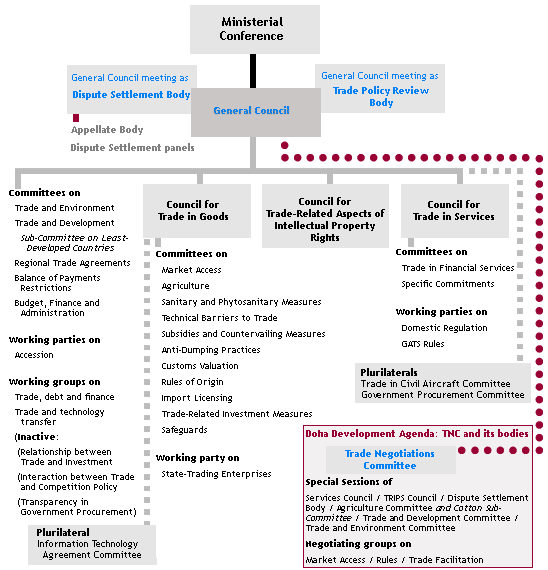Life Skills Development/Unit Six/The Economic Environment/Lesson
Contents
|
Question: What is a single market? Answer: This is an economic system where goods, services, people, technology and capital are able to move freely from one location to another without having to deal with restrictions and approvals of various kinds. In essence, The Bahamas makes up a single market, where goods, services, people, capital and technology are able to move freely between islands from Abaco to Inagua without permits, restrictions and approvals. The freedom of movement of people, capital, goods and services across the United States, is also an example of a single market.
|
|
Question: What exactly is a single economy? Answer: This is a situation that goes a few steps further than a single market and involves close cooperation between the Caribbean states on general policy matters affecting industry, trade, money, investment, agriculture, transport, competition, consumer protection, human and social development and trade dispute settlement.
|
Caribbean Single Market and Economy
The CARICOM Single Market and Economy also known as the Caribbean Single Market and Economy or CSME is an integrated development strategy envisioned at the 10th Community which took place in July 1989 in Grand Anse, Grenada.
The Grand Anse Declaration had the key features:
- Deepening economic integration by advancing beyond a common market towards a Single Market and Economy.
- Widening the membership and thereby expanding the economic mass of the Caribbean Community (e.g. Suriname & Haiti were admitted as full members in 1995& 2002 respectively).
- Progressive insertion of the region into the global trading and economic system by strengthening trading links with non-traditional partners.
The Single Market and Economy will be implemented through a number of phases, the first being the CARICOM Single Market (CSM). The CSM was initially implemented on 1, 2006. The Single Economy however, is only expected to be fully implemented in 2008 with harmonization of economic policy and a single currency.
Full Members of the CSME
- ANTIGUA & BARBUDA
- BARBADOS
- BELIZE
- DOMINICA GRENADA GUYANA
- JAMAICA
- MONTSERRAT
- ST KITTS
- ST LUCIA
- ST VINCENT AND THE GRENADINES
- TRINIDAD AND TOBAGO
Trade in Goods
All goods which meet the CARICOM rules of origin are traded duty free throughout the region (except The Bahamas), therefore all good originating within the region can be traded without restrictions. In addition, most member states apply a Common External Tariff (CET) on good originating from non-CARICOM countries. There are, however, some areas still to be developed:
- Treatment of products made in Free Zones – there is need for regional agreement on how these goods are to be treated since they are usually manufactured at reduced tariff by foreign companies.
- The removal of some specific non-tariff barriers in various member-states.
Another key element in relations to goods is Free Circulation. This provision allows for the free movement of goods imported from extra regional sources which would require collection of taxes at first point of entry into the CSME and for the sharing of collected customs revenue.
Harmonization of Standards
Complementary to the free movement of goods will be the guarantee of acceptable standards of these goods and services. To accomplish this, CARICOM members have established the Caribbean Regional Organization on Standards and Quality (CROSQ). The Organization will be responsible for establishing regional standards in the manufacture and trade of goods which all Member States must adhere to. This Organization was established by a separate agreement from the CSME.
Trade in Services and The Right of Establishment
Along with the free trade in goods, the Revised Treaty also provides the framework for the establishment of a regime for free trade in services. The main objective is to facilitate trade and investment in the services sectors of CSME Member States through the establishment of economic enterprises. The free trade regime for services grants the following benefits:
- The Right of Establishment - CARICOM-owned companies will have the right to establish and operate businesses in any CSME member-state under the same terms and conditions as local companies, i.e. without restrictions. Managerial, technical and supervisory staff of these enterprises will be able to enter and work without work permits (see 'Work Permits and the Free Movement of People' below).
- Region-wide Services - CARICOM service providers will be able to offer their services throughout the region, again without work permits, usually on a temporary basis, e.g., consultancies.
Work Permits and the Free Movement of People
The Free Movement of Skilled Persons, arises from an agreed CARICOM policy that was originally separate but related to the original Protocol II of the Revised Treaty of Chaguaramas. The agreed policy, called The Caribbean Community (CARICOM) Free Movement of Persons Act, is now enacted legislation in all the CSME Member States. It provides for the free movement of certain categories of skilled labour, but according to the policy there is to be eventual free movement of all persons by 2008. Under this legislation, persons within these categories can qualify for Skills Certificates (which allow for the free movement across the region).
Since the start of the CSM, eight categories of CARICOM nationals have been eligible for free movement throughout the CSME without the need for work permits. They are: University Graduates, Media Workers, Artistes, Musicians, Sportspersons, Managers, Technical and Supervisory Staff attached to a company and Self-Employed Persons/Service Providers. In addition the spouses and immediate dependent family members of these nationals will also be exempt from work permit requirements. At the July 2006 CARICOM Summit, it was agreed to allow for free movement of two more categories of skilled persons; tertiary-trained Teachers and Nurses. It was also agreed that higglers, artisans, domestic workers and hospitality workers are to be added to the categories of labour allowed free movement at a later date, pending the agreement of an appropriate certification.
The freedom to live and work throughout the CSME is granted by the Certificate of Recognition of CARICOM Skills Qualification (commonly called a CARICOM Skills Certificate or just Skills Certificate). The Skills Certificate essentially replaces work permits and can be obtained from the requisite ministry once all the essential documents/qualifications (which varies with each category of skilled persons) are handed in with an application. The issuing ministry varies depending upon the CARICOM Member State. In Antigua and Barbuda, Jamaica and Suriname the Skills Certificates are issued by the Ministry of Labour. Grenada, Guyana, St. Lucia and Trinidad and Tobago have Ministries for Caribbean Community Affairs which deal with the Certificates. Meanwhile, Barbados, Belize, Dominica, St. Kitts and Nevis and St. Vincent and the Grenadines issue the Certificates through the Ministries of Immigration. The Skills Certificate can be applied for in either the home or host country.
The Free Movement of Labour is also being facilitated by measures to harmonize social services (health, education, etc.) and providing for the transfer of social security benefits (with the Bahamas also being involved). Regional accreditation will also facilitate the free movement of people/labour.
Concurrent with (and to some extent pre-dating) the free movement of people is the easier facilitation of intra-regional travel. This aim is being accomplished by the use of separate Lines identified for CARICOM and Non-CARICOM Nationals at Ports of entry (already in place for all 13 members) and the introduction of a CARICOM passport and Standardized Entry/Departure Forms.
Free Movement of Capital
The free movement of Capital involves the elimination of the various restrictions such as foreign exchange controls and allowing for the convertibility of currencies (already in effect) or a single currency and capital market integration via a regional stock exchange. The member states have also signed and ratified an Intra-Regional Double Taxation Agreement.
Single Currency
Although not expected until at least 2008 (and even that date will probably be subject to delays) it is intended that the CSME will have a single currency. As it stands a number of the CSME members are already in a currency union with the East Caribbean dollar and the strength of most regional currencies (with the exception of Jamaica's and Guyana's) should make any future exchange-rate harmonization between CSME members fairly straightforward as a step towards a monetary union.
The aim of forming a CARICOM monetary union is not new. As a precursor to this idea the various CARICOM countries established a compensation procedure to favour the use of the member states currencies. The procedure was aimed at ensuring monetary stability and promoting trade development. This monetary compensation scheme was at first bilateral, but this system was limited and unwieldy because each member state had to have a separate account for each of its CARICOM trade partners and the accounts had to be individually balanced at the end of each credit period. The system became multilateral in 1977 and was called the CARICOM Multilateral Clearing Facility (CMCF). The CMCF was supposed to favour the use of internal CARICOM currencies for transaction settlement and to promote banking cooperation and monetary cooperation between member states. Each country was allowed a fixed credit line and initially the CMCF was successful enough that both the total credit line and the credit period were extended by 1982. However, the CMCF failed shortly thereafter in the early 1980s due to Guyana’s inability to settle its debts and Barbados being unable to grant new payment terms
Despite the failure of the CMCF, in 1992 the CARICOM Heads of Government determined that CARICOM should move towards monetary integration and commissioned their central bankers to study the possible creation of a monetary union among CARICOM countries. It was argued that monetary integration would provide benefits such as exchange rate and price stability and reduced transaction costs in regional trade. It was also thought that these benefits in turn would stimulate capital flows, intra-regional trade and investment, improve balance of payments performance and increase growth and employment.
The Central Bank Governors produced a report in March 1992 that outlined the necessary steps and criteria for a monetary union by 2000. The 1992 criteria were amended in 1996 and were known as the 3-12-36-15 criteria. They required that:
- Countries maintain foreign reserves equivalent to 3 months of import cover or 80% of central bank current liabilities (whichever was greater) for 12 months;
- The exchange rate be maintained at a fixed rate to the US dollar (for Fixers) or within a band of 1.5% on either side of parity (for Floaters) for 36 consecutive months without external debt payment arrears and;
- The debt service ratio to be maintained within 15% of the export of goods and services.
The report envisioned the fulfillment of a monetary union in 3 phases on the basis of grouping the member states into 2 categories, A and B. Category A included the Bahamas, Belize and OECS states. Category A countries had already met the original criteria in 1992 and only had to maintain economic stability to begin the monetary union. Category B consisted of Barbados, Guyana, Jamaica and Trinidad and Tobago (Suriname and Haiti were not yet members and so were not included). These countries had to make the necessary adjustments to meet the entry criteria.
Phase 1 of the monetary union process was scheduled to conclude in 1996. It was to include the Bahamas, Barbados, Belize, the OECS states and Trinidad and Tobago and there was to have been a common currency as a unit of account (cf. the Euro from 1999 - 2002) amongst these states with the exception of the Bahamas and Belize. This phase would also involve the coordination of monetary policies and the movement towards intra-regional currency convertibility among all member states. Phase 1 would also have seen the formation of a Council of CARICOM Central Bank Governors to oversee the entire process.
Phase 2 was to have occurred between 1997 and 2000 and should have seen a number of initiatives:
- The formation of a Caribbean Monetary Authority (CMA), which would be accountable to a Council of Ministers of Finance.
- The issuance and circulation of a physical common currency in all Phase 1 countries except the Bahamas.
- The use of the new currency in the other countries (the Bahamas, Guyana and Jamaica) as a unit of account in settling regional transactions.
- The continued efforts by Guyana and Jamaica to meet the criteria for entry into the monetary union if they had not already done so and achieved economic stability.
Phase 3 was planned to begin in 2000 and had as its ultimate goal to have all CARICOM countries entering into the monetary union and membership of the CMA. However, the implementation of Phase 1 was put on hold in1993 as a result of Trinidad and Tobago floating its dollar. In response and in an effort to continue pursuing monetary cooperation and integration, CARICOM Central Bank Governors made their regional currencies fully inter-convertible. A subsequent proposal called for Barbados, Belize and the OECS states to form a currency union by 1997 but this also failed.
|
Question: What are the proposed benefits of the CSME? Answer: This close cooperation in commercial activity is expected to raise the standard of living of the vast majority of the 14 million people who live in the CARICOM region. It is expected that this close economic cooperation will lead to an increase in competition among the providers of goods and services in the Region and thus cause a reduction in the prices of goods and services. A reduction in the prices of goods and services should lead to increased savings and investments and thus raise the standard of living in the Community. So, this is the essence of the trade proposal called the CARICOM Single Market and Economy: it is designed to improve the standard of living in the region by lowering the cost of living while ensuring that top quality goods and services are available to the more than 14 million consumers from The Bahamas in the North to Suriname in the South.
|
|
Question: What is the FTAA? Answer: Free Trade Area of the Americas. A trade agreement among the 34 countries in the Western Hemisphere in which they have agreed to eliminate trade and investing barriers on virtually all goods and services traded by member countries, reducing prices for consumers and creating new markets for producers throughout the Hemisphere.
|
|
Question: How does the FTAA affect the Caribbean nations? Answer: The FTAA will constitute the largest trading bloc in the world, with a combined Gross Domestic Product of over US$7.7 trillion and a total market of 757 million people. Member States of the FTAA therefore, will have access to such opportunities as enhanced trade and investments, improved market access, improved quality of life and increased foreign exchange earnings. The location of the FTAA Permanent Secretariat in Trinidad and Tobago will benefit other Caricom countries, as it will serve to raise the profile of the entire Caribbean region, while contributing ancillary benefits to the respective economies. Direct benefits to the region as a result of hosting the Permanent Secretariat include increased opportunities for regional tourism, more effective participation of Caribbean Member States in the FTAA and lower member contributions as a result of lower operational Secretariat costs. If Trinidad and Tobago succeeds in getting the nod for the FTAA Secretariat, the ultra modern facility would be located in the heart of the nation's capital, with no shortage of necessary infrastructure, modern telecommunications and other support services.
|
The World Trade Organisation
The World Trade Organization (WTO) is an international body whose purpose is to promote free trade by persuading countries to abolish import tariffs and other barriers. As such, it has become closely associated with globalisation.
The WTO is the only international agency overseeing the rules of international trade. It polices free trade agreements, settles trade disputes between governments and organises trade negotiations. WTO decisions are absolute and every member must abide by its rulings. So, when the US and the European Union are in dispute over bananas or beef, it is the WTO which acts as judge and jury. WTO members are empowered by the organisation to enforce its decisions by imposing trade sanctions against countries that have breached the rules.
Overview
Based in Geneva, the WTO was set up in 1995, replacing another international organisation known as the General Agreement on Tariffs and Trade (GATT). GATT was formed in 1948 when 23 countries signed an agreement to reduce customs tariffs.
The WTO has a much broader scope than GATT. Whereas GATT regulated trade in merchandise goods, the WTO also covers trade in services, such as telecommunications and banking, and other issues such as intellectual property rights.
Membership of the WTO now stands at 150 countries. China formally joined the body in December 2001 after a 15-year battle. Russia wants admission, but must first convince the EU and US that it has reformed business practices.
The highest body of the WTO is the Ministerial Conference. This meets every two years and, among other things, elects the organisation's chief executive - the director-general - and oversees the work of the General Council.
The Ministerial Conference is also the setting for negotiating global trade deals, known as "trade rounds" which are aimed at reducing barriers to free trade.
The General Council is in charge of the day-to-day running of the WTO and is made up of ambassadors from member states who also serve on various subsidiary and specialist committees.
Among these are the Dispute Settlement Panels which rule on individual country-against-country trade disputes.
Facts
- Founded: 1995
- Members: 150 states (January 2007)
- Budget: 125 million US dollars
- Staff: 601
- Key players: US, the EU, Japan
Issues
The WTO has been the focal point of criticism from people who are worried about the effects of free trade and economic globalisation. Opposition to the WTO centres on four main points:
- WTO is too powerful, in that it can in effect compel sovereign states to change laws and regulations by declaring these to be in violation of free trade rules.
- WTO is run by the rich for the rich and does not give significant weight to the problems of developing countries. For example, rich countries have not fully opened their markets to products from poor countries.
- WTO is indifferent to the impact of free trade on workers' rights, child labour, the environment and health.
- WTO lacks democratic accountability, in that its hearings on trade disputes are closed to the public and the media.
Supporters of the WTO argue that it is democratic, in that its rules were written by its member states, many of whom are democracies, who also select its leadership.
They also argue that, by expanding world trade, the WTO in fact helps to raise living standards around the world.
Advantages and disadvantages
Advantages
- It helps trade to flow smoothly.
- It deals with disputes over trade.
- Decisions in the WTO are made by consensus and the agreements apply to everyone.
- All countries can appeal against decisions which they feel are unfair. This system has the potential to protect developing countries from harsh measures and unfair rules.
Disadvantages
- The rules are not fair.
- The rules are too complex. Poorer countries cannot afford to pay specialists, lawyers and other support staff to help them to interpret or challenge them.
- Poorer countries cannot afford to attend meetings
- The WTO has too much power compared with other international organisations.
- The decisions that it makes take precedence over agreements on the environment and international law for example.
|
Question: What is the Trade Justice Movement? Answer: The Trade Justice Movement [TJM] is a coalition of charities, Aid workers, and campaigning organizations for change in International Trading. It is calling for basic changes to unjust rules in institutions such as the European Union [EU], World Trade Organization [WTO] and the World Bank, so that trading works fairly and takes millions of people out of poverty. They aim to obtain fair trade prices for the poorer nations. However neither Free Trade nor Fair Trade will be an answer in itself, what is required is Justice.
|
|
Question: Why has all this suddenly become possible? Answer: The G8 summit will be hosted by UK in July at Gleneagles in Scotland and therefore the UK sets the agenda and is in prime position to push the issue of poverty, fairer trade and canceling third world debt. From July to December the UK will have the Presidency of the EU, and this provides an opportunity to push these issues through and commit the EU to negotiate fairer international trade rules. In December 2005 the WTO has a ministerial meeting in Hong Kong and it is the final deadline for the deals. Fringe benefits from fair-trading would include far less immigration problems if the standard of living between 1st World and 3rd World were more equal. Fewer people would choose to move to an environment and culture with which they are unfamiliar.
|
|
Question: What is G8? Answer: Group 8 (G8) is made up of the world’s strongest economies: - Canada, France, Germany, Italy, Japan, Russia, the United Kingdom and the United States. It was established in 1975. Representatives from these countries meet to discuss economic concerns. These countries determine the policies that govern international trading.
|
|
Debate one of the following topics. Or, if a debate is not possible, then write your arguements for and against the following topics:
|
Portfolio Contents
- List of benefit and pitfalls of CARICOM
- Notes on discussions/debates
- Points, preparation and Speech for Class debate
- SWOT Analysis matrix for the CSME and FTAA.
Checklists of Performance Task
1.
| RUBRIC of performance criteria | V. Well Done | Well Done | OK | Not Ok- Will redo by …. | |
|---|---|---|---|---|---|
| 1. | I expressed my views at least once during the course of both discussions | ||||
| 2. | I spoke on the FTAA and the CSME effectively | ||||
| 3. | I know the importance of the G8 summit and international trade as a whole | ||||
| 4. | I have a better understanding of the CSME and its impact on in my country |
| RUBRIC of performance criteria | V. Well Done | Well Done | OK | Not Ok- Will redo by …. | |
|---|---|---|---|---|---|
| 1. | I have a better understanding of the work environment throughout Trinidad and Tobago | ||||
| 2. | I researched the topic thoroughly |
| RUBRIC of performance criteria | V. Well Done | Well Done | OK | Not Ok- Will redo by …. | |
|---|---|---|---|---|---|
| 1. | I have expressed my views on the advantages and disadvantages of regional trade agreements such as the CSME and the FTAA | ||||
| 2. | I have a better understanding of the agencies that direct international trade | ||||
| 3. | I understand the effects such trade agreements have on Trinidad and Tobago |




